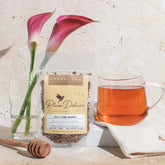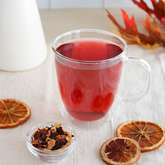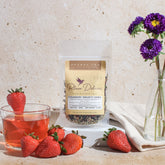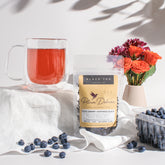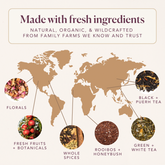While I don’t recommend that you eat tea leaves like that, it is possible – dare I say, advisable – to eat tea leaves under certain circumstances. Loose leaf teas are wonderful as a rub, a brine, a marinade, or thrown straight into a recipe as an ingredient. Let your imagination run wild!
No matter how you prepare them, here are some basic rules of thumb (or should I say... rules of “yum”) to keep in mind when consuming tea leaves.

Use a Grinder
The first thing to know is that, ideally, your tea leaves should be as finely ground as possible. There’s a reason that matcha powder – which is very finely ground green tea – is the most common way to ingest tea leaves.
Grinding the leaves to a consistency anywhere from small chunks to a fine powder will help ease digestion and generally improve the texture of the final dish. Tossing whole leaves into most recipes – say, frosting, for example – will result in unpleasant chunkiness and odd bursts of flavor. No one wants to pick entire splinters of lemongrass out of their teeth while enjoying their cupcake.
Whenever possible, pulverize your leaves with a spice grinder, a coffee grinder, a food processor, or if you want to burn some calories before you eat, a mortar and pestle. Remember, fine grinding equals fine dining.

You Are What You Eat
There is both an upside and a possible downside to eating your tea leaves.
First, the good news: All the benefits you get when you drink tea are magnified when you eat tea. For those of you who include tea as part of your daily health regimen, this is fantastic news. You can supercharge that dose of antioxidants by going straight to the source – leave out that watery middleman and get the complete nutrient into your system!
Be careful not to overdo it, though. This concentration of nutrients can be a double-edged sword.
In addition to increasing your intake of other vitamins and minerals when you swap out sipping tea in favor of chewing it, you’ll also amp up your fiber intake. On the one hand, this could be considered a positive, especially since – generally speaking – we don’t get enough fiber in our diets. But when you abuse the power of the leaves, it could lead to digestive discomfort down the line. (Raise your hand if you’ve already learned this lesson the hard way by getting overly enthusiastic about kale...) Too much of a good thing is just that: too much.
The same can be said for the caffeine levels in tea. If you love the jolt of energy you get from your daily cuppa, just know that your little boost could be more of a blast when you eat the whole leaf rather than steeping and discarding.
There are also some who caution against eating tea whole because of pesticides and other potentially harmful substances that might remain on the leaves. Others say these amounts are so trace that they’re more or less negligible and there’s nothing to worry about. I say: If you stick with Plum Deluxe blends, you know you’re getting mindfully sourced, organic ingredients, so no problem! Plus, you won’t be eating tea leaves too often anyway, right? (Right? Remember that section?)
All in all, eating tea leaves can be a healthy, delicious way to get a concentrated dose of all the goodness that tea has to offer! Not to mention, they’re lots of fun to experiment with in recipes. Which leads us to point number three...

Get Creative!
Explore traditional dishes using tea leaves, or create some of your own! Here are a few ideas to get you started.
While eating tea may be a relatively new concept for us, other cultures figured out the wonders of cooking with tea leaves ages ago. Zhangcha duck – or tea-smoked duck – is a popular dish that the Sichuan region of China is rightly famous for. If you’ve never had it, it’s worth tracking down! Or if chicken is more your style, try making Plum Deluxe’s twist on smoked duck with this tea-smoked chicken.
Laphet thoke, a Burmese salad made with fermented or pickled tea leaves, is a delightful and surprising dish which hails from Myanmar. This salad has a distinct combination of flavors and textures that pleases the palate in so many ways; it’s savory, tangy, zesty, and fresh, with a wonderful crunch that keeps you coming back for more. If you’ve ever complained that salads are boring, mix it up with Burmese tea leaf salad. It’s a game-changer.
These traditional dishes have stood the test of time for a reason (once you taste them, you’ll wonder why you’ve spent your entire life thus far not eating tea). However, feel free to experiment to your heart's (and taste buds’) content to create your own recipes. If you follow the first two Rules of Yum listed above, there is no end to the possibilities of flavor combinations you can create.
Use tea leaves in baked goods, on meats, with soups, breads, salads – basically anything you can think of. If you can eat it, then you can eat it with tea leaves.

Types of Tea to Eat
Matcha is one of the easiest and most versatile tea forms to work with. Since it’s already powdered, it’s a cinch to throw into pretty much anything! For a simple twist on buttercream frosting, check out this matcha frosting recipe. The natural pop of green and mild unique flavor instantly transform any baked good into a “baked great!” Or try these matcha crepes for a breakfast base that can be supplemented with either sweet or savory ingredients, depending on the notes in your matcha. Start your day off with a sour cream matcha muffin, or end it with a bright green matcha mousse. From sunup to sundown, you can enjoy matcha in your food any time of day!
Branch out into other types of tea with Earl Grey brownies. You can grind your favorite Earl Grey leaves and mix them directly into batter, then infuse them into the frosting drizzle for a tea-time double whammy! Or, if you’d like to incorporate tea into your main dishes, this Sweet Tea Rib Rub is an awesome place to start!
Personally, I like to throw a bit of Hello Sunshine herbal blend into my curries. The notes of turmeric, cinnamon, black pepper, and lemongrass compliment the natural flavors of the dish perfectly!
A nice helping of Fireside Chat smoked black tea is an ideal accompaniment to chilis and meats. The smoky flavor really comes through, and that subtle hint of chocolate adds an interesting depth of flavor you just can’t beat!
There’s so much to try in the world of eating tea leaves. So if you’ve ever wondered, “Can you eat tea leaves?” tell yourself, “Absolutely!” and get cooking!
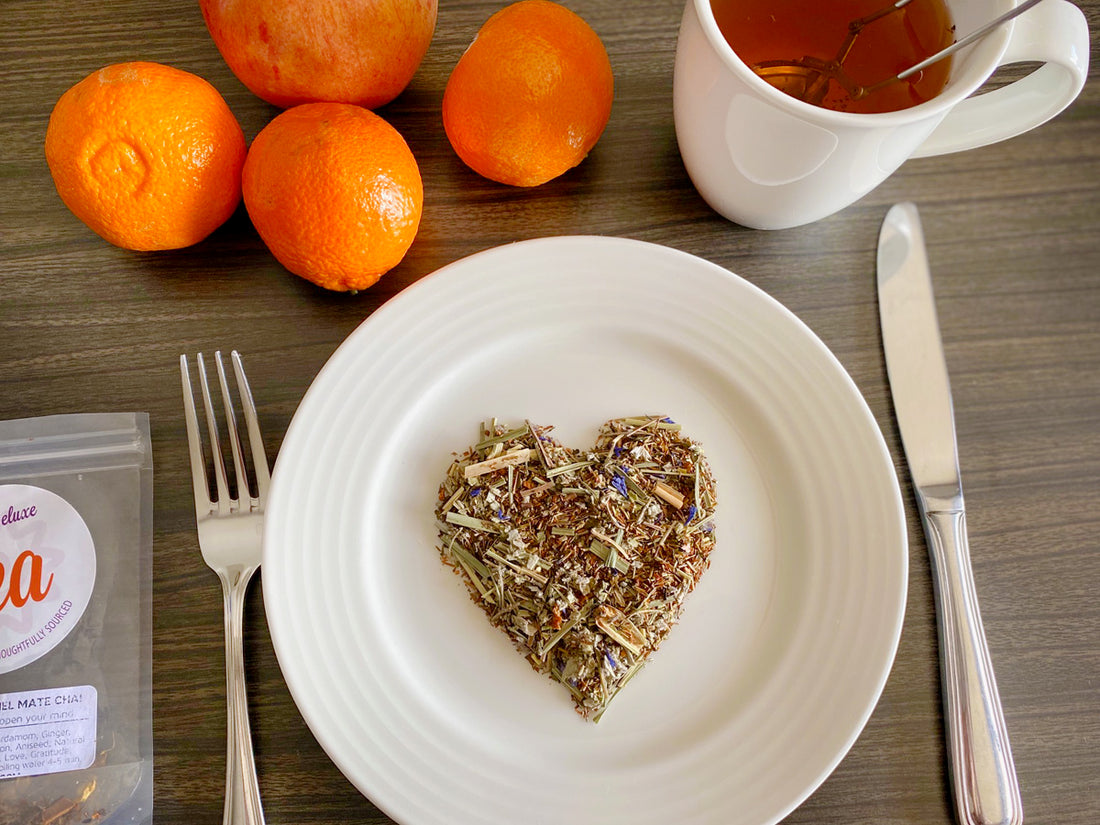
![Holiday Tea Variety Pack [6-Pack Variety of Flavors]](http://www.plumdeluxe.com/cdn/shop/files/holidayTeaVarietyPack.png?v=1759777907&width=165)


